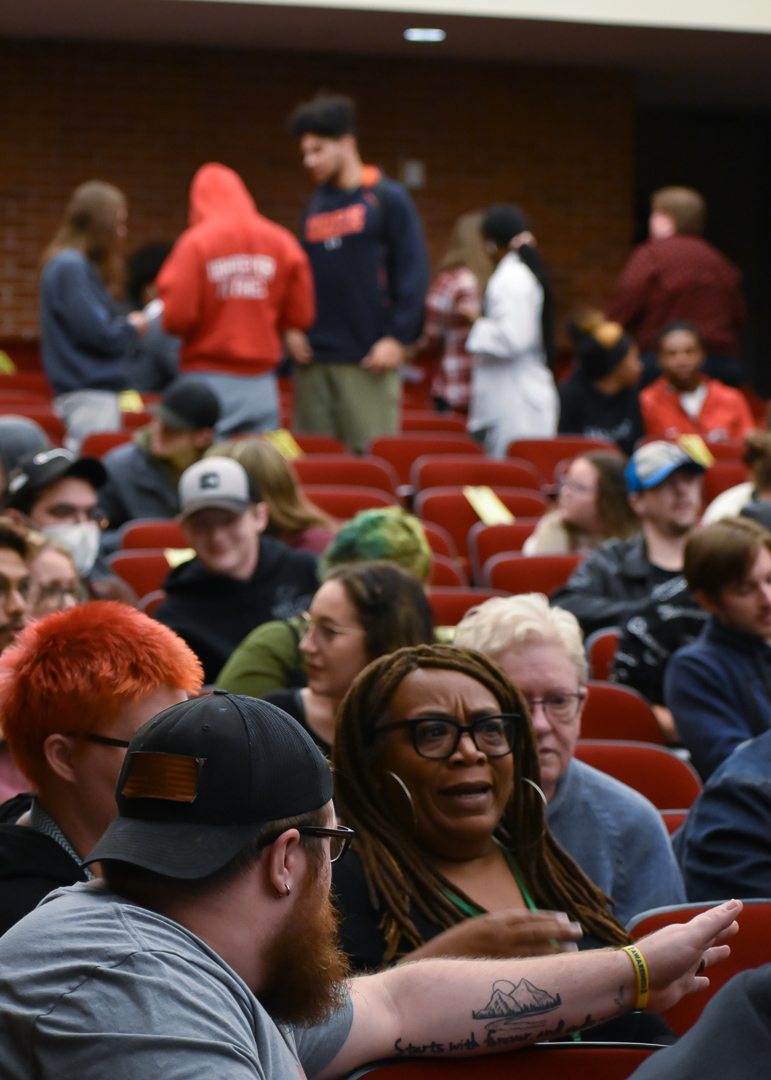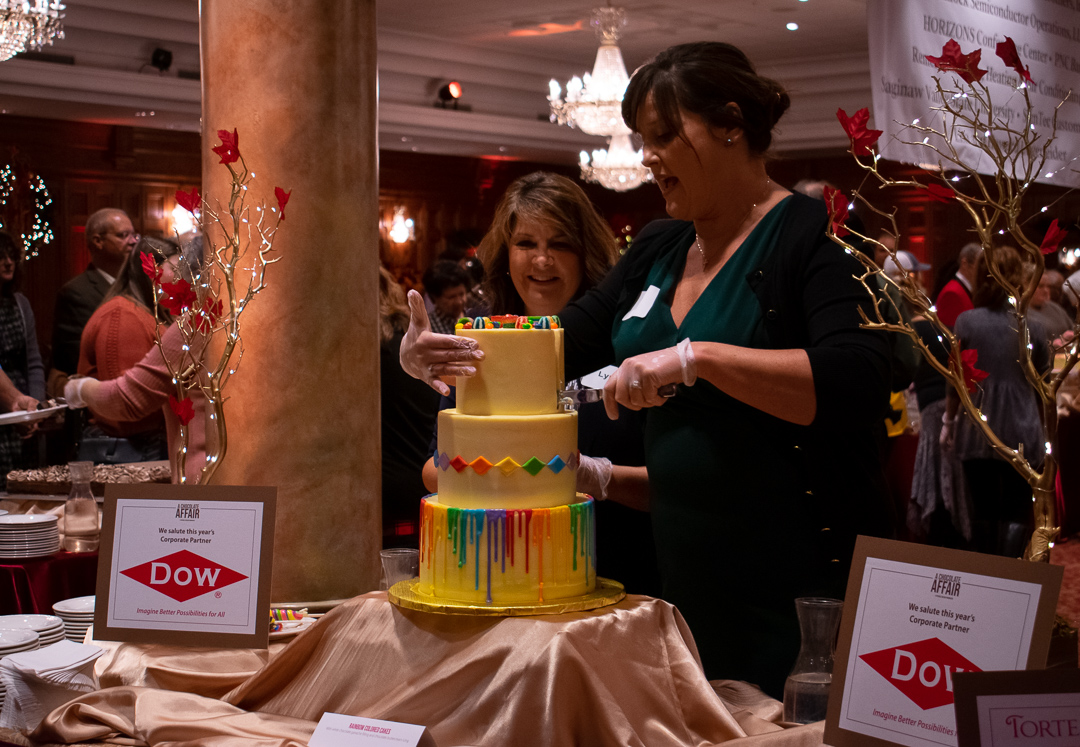A collaborative article by Courtney Elisech and Vincent Khan
By Courtney Elisech
Tuesday, Sept. 27, was a night of learning for many at Delta College. A panel of experts discussed one of the hottest topics right now, abortion, in a lecture room full of students and community members.
Roe v. Wade was overturned on June 24, and reproductive rights have since been the heart of many talks, splashed all over social media, and in the forefront of many American minds. This event was an open talk about abortion and the history of the laws on reproductive rights.
The event was broken into three segments, where the panelists spoke on a question surrounding abortion and reproductive rights and laws. The audience then collaborated together in small groups for further discussion.
At the end of the three segments, the audience had an opportunity to ask questions. This was when a representative from each small group could bring new topics to the table.
A last-minute change had Attorney General Dana Nessel joining the deliberative dialog via a video call. Technology was not on her side as her mic only worked one out of the three times she was to speak.
“The 1931 laws immediately sprang back into effect,” Nessel said. She shared that there were many cases filed against her preemptively to the overturning of Roe v. Wade, even though she had pledged never to enforce the old laws from 1931. “No politician in Lansing or Washington should be able to tell a woman what they can do with their body.”
In Michigan, the voters now have the future of legal abortion access in the state in their hands.
Nov. 8 on the general election ballot will be Proposal 3. A vote in favor means writing reproductive freedom into the state’s constitution and invalidating the 1931 abortion ban law. Voting no puts the right to legal abortion in elected officials’ hands.
Dr. Lisa Lawrason is a political science professor at Delta College and was among the panel of experts. She shared the history leading up to the overturning of Roe v. Wade beautifully, in a way that was easy to understand.
She began by telling the story of Norma McCorvey. Is that name familiar? If not, it should be. What about Norma’s pseudonym Jane Roe? Is the name Roe sticking out to you?
In 1971 Norma was 20 years old when she sought an abortion in Texas. She was denied because the law stated she could not have an abortion unless her life was in jeopardy. It was a felony.
Norma already had two children that were not in her custody. Her first child was raised by her mother, and the second by her father. Norma was young and uneducated after dropping out of school. She was vulnerable and felt she could not care for this child that would later be given up for adoption.
When she could not have an abortion legally, she was sent to a lawyer who could challenge the law. She used the name Jane Roe to protect herself, later becoming infamous for playing a significant role in the decision in Roe v. Wade. It took years for her to fight her case, and it went to the supreme court. In 1973 the case legalized abortions nationwide.
Dr. Lawrason explained that the legislative branch, state or federal, determines the law. The judicial branch determines what the law is and lends meaning to it by interpreting it. On top of this is the supreme court.
“The Supreme Court is the court of last resort,” Lawrason said. “And has the final decision on what the constitution says. Nowhere in the constitution does it mention abortion.”
How can the decision fall to the supreme court if it is not in the constitution? Though it is not explicitly stated, it was found that restricting the right to legal abortion violated the rights to privacy given in the constitution.
Who should decide abortion rights and reproductive rights? Are there exceptions to be made or circumstances that make a difference in the decision? Should reproductive rights be stated explicitly in the constitution?
Each time the audience had a chance to talk with each other, it was clear that people came to share their opinions. Looking around the room, you could see people talking about the subject. Passion showed through as they shared stories and experiences, speaking about what the law should be and what it is.
The panel also had Dr. Audrey Stryker, an OBGYN, Dr. Michelle Monticello, the co-Medical Director for Life Choices of Mich., and Delta College Professor Christina Miller-Bellor, a professor of Sociology.

“Being an OB is the coolest job in the world,” Dr. Stryker began. She shared that she was happy to be at Delta College discussing what she called “one of the most important women’s health issues of our generation.”
Why do people seek abortions? Not many people classify abortion as birth control or have many abortions. It is a major medical decision.
Dr. Stryker shared many eye-opening stories, from fertility issues to abortions to life-saving measures that ultimately failed. She is a welcoming, funny, and knowledgeable doctor who wants to help others understand that there is more to abortion than just the word and stigma surrounding it.
The number one reason abortion is needed is for the medical safety and the risks associated with the pregnancy. Social and financial issues also play a part in the decision. What is the woman to do without the means to care for the child? There are many who would say to have the child and give it up. What about the physical risks involved in pregnancy that the mother will still have to endure?
The evening was a learning opportunity for many. It was not a debate as many thought it would be, but more an open dialog to discuss the unknowns.
Abortion is a complex topic to discuss. Delta Collegiate’s own Vincent Khan aptly described abortion as taboo when the audience was open to questions. The only way to learn more and make a change is to talk about it, visit events like this one, step outside the comfort zone and listen to stories that are hard to hear.
By Vincent Khan
Delta College’s Roe v. Wade event was the opposite of my expectations. When I heard about the event, I thought it would be a debate. After looking up information and attending, I discovered it was a civil discussion.

A panel of five speakers talked about the taboo topic. It consisted of social workers, a political science major, an OBGYN with many other credentials, and Michigan’s very own attorney general.
Everyone speaking that night on the panel was female, which I found appropriate.
One speaker would talk for about ten minutes before the audience separated into five groups to brainstorm the discussion questions provided on the event brochure. No speaker ever exclaimed their stance on abortion. Instead, they relayed understanding to the audience about the history, trends, statistics, and myths versus facts surrounding the topic.
The discussion questions did not in any way make you choose a side between pro-life and pro-choice. They made everyone think about who is affected, how they are affected, and the timeline of the history of abortion rights in America.
My partner and I were grouped up with an older adult woman and man, and one young man in his late teens.
It was very interesting to hear the different viewpoints of people of different ages, races, and genders. One lady in my group had firsthand experience with an abortion decision leading to adoption. I found it courageous of her to be able to tell her story to strangers.
I give huge props to the event coordinators for curating an open environment for everyone to share their opinions and stories comfortably. I don’t think the lady in my group would have shared her story if it wasn’t for that.
At the end of the event, a microphone was passed around the audience for questions to the panel. Not to debate a side, but just to ask questions to the panel.
Questions about foster care and male responsibility came up. The last question asked to the panel was, “how do we make abortion an easier topic to talk about?”
The panel was delighted by this question because that was the very point of the night.
“Setting up an event like this with experts helps people get on the same page,” Panel member Dr. Audrey Stryker said. “It allows people to become more comfortable talking about this topic with a more informed and educated opinion. We have such a big divide in this country about what is right and wrong with abortion, but not everyone knows the history or all of the facts and factors around this topic.”
With the November midterm elections coming up, the abortion stance is a big bubble to fill in for every voter. I appreciate how this event did not make people more divided, but instead, it made people understand the issue more. Those who attended this event will now be more confident in their vote. Now having talked to experts, maybe someone has changed their stance.























